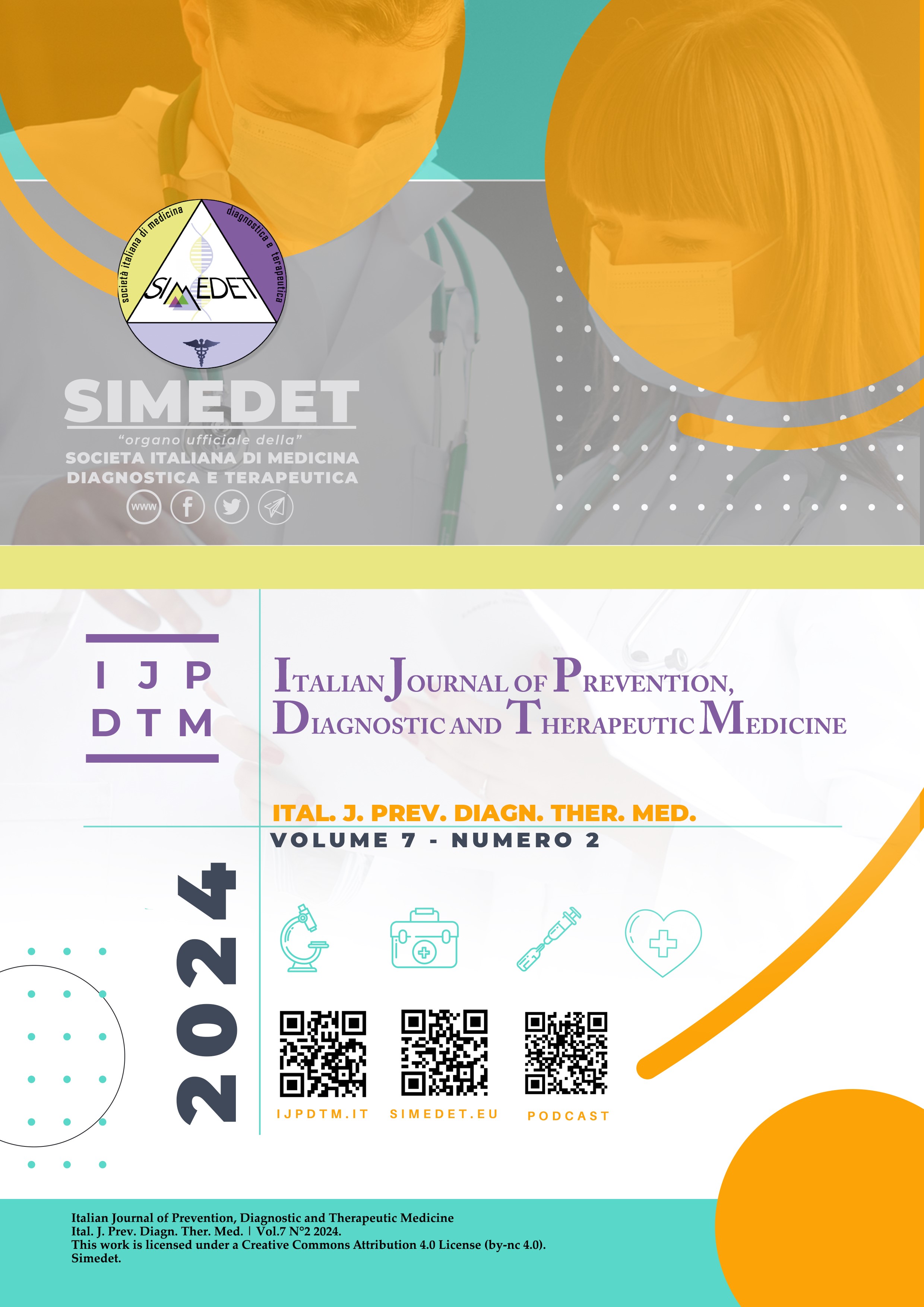Sepsis and precision medicine a new challenge
Main Article Content
Abstract
Sepsis is defined as Systemic Inflammatory Response Syndrome (SIRS) caused by an infectious agent; it involves millions of individuals yearly and it is classified as an emerging health problem.
The therapeutic focus has mainly been on early diagnosis, appropriateness of anti-infective treatment, early resuscitation and support intervention for organ failure. Despite undeniable progress, mortality remains unacceptably high.
In the era of precision medicine, the hypothesis that the lack of “personalization” of therapeutic management is the basis of clinical failures is increasingly gaining ground.
Progress towards greater clinical effectiveness in the management of sepsis passes through the implementation of precision medicine, capable of individualizing treatment based on the combination of the clinical phenotype and the immunological profile.
The application of new “omics” technologies (genomics, epigenomics, transcriptomics, metabolomics, proteomics, lipidomics and microbiomics) has brought further information on the pathophysiological complexity of sepsis.
The step still to be taken is therefore to integrate the knowledge obtained from these multi-omics approaches into clinical management to identify new diagnostic targets or effective therapeutic strategies, with the aim of treating the individual patient in a personalized way based on the etiological agent, and the specific immune response, in different clinical settings.
Downloads
Article Details

This work is licensed under a Creative Commons Attribution-NonCommercial 4.0 International License.
References
Guarino, M.; Perna, B.; Cesaro, A.E.; Maritati, M.; Spampinato, M.D.; Contini, C.; De Giorgio, R. 2023 Update on Sepsis and Septic Shock in Adult Patients: Management in the Emergency Department. J. Clin. Med. 2023, 12, 3188.
de Grooth, H.-J.; Postema, J.; Loer, S.A.; Parienti, J.-J.; Oudemans-van Straaten, H.M.; Girbes, A.R. Unexplained Mortality Differences between Septic Shock Trials: A Systematic Analysis of Population Characteristics and Control-Group Mortality Rates. Intensive Care Med. 2018, 44, 311.
Singer M, Deutschman CS, Seymour CW, Shankar-Hari M, Annane D, Bauer M, Bellomo R, Bernard GR, Chiche JD, Coopersmith CM, Hotchkiss RS, Levy MM, Marshall JC, Martin GS, Opal SM, Rubenfeld GD, van der Poll T, Vincent JL, Angus DC. The Third International Consensus Definitions for Sepsis and Septic Shock (Sepsis-3). JAMA 2016; 315: 801.
Hotchkiss, R.S.; Monneret, G.; Payen, D. Sepsis-Induced Immunosuppression: From Cellular Dysfunctions to Immunotherapy. Nat. Rev. Immunol. 2013, 13, 862.
Cavaillon, JM; Singer, M.; Skirecki, T. Sepsis Therapies: Learning from 30 Years of Failure of Translational Research to Propose New Leads. EMBO Mol. Med. 2020, 12, e10128.
Yébenes JC, Ruiz-Rodriguez JC, Ferrer R, Clèries M, Bosch A, Lorencio C, Rodriguez A, Nuvials X, Martin-Loeches I, Artigas A; SOCMIC (Catalonian Critical Care Society) Sepsis Working Group. Epidemiology of sepsis in Catalonia: analysis of incidence and outcomes in a European setting. Ann Intensive Care 2017; 7: 19.
Global Report on the Epidemiology and Burden of Sepsis: Current Evidence, Identifying Gaps and Future Directions—World|ReliefWeb. Available online: https:// reliefweb.int/report/world/global-report-epidemiology-and-burden-sepsiscurrent-evidence-identifying-gaps-and (accessed on 9 January 2024).
Ruiz-Rodriguez JC, Plata-Menchaca EP, Chiscano-Camón L, Sanmartin AR, Pérez-Carrasco M, Palmada C, Ribas V, Martínez-Gallo M, Hernández-González M, Gonzalez-Lopez JJ, Larrosa N, Ferrer R. Precision medicine in sepsis and septic shock: from omics to clinical tools World J Crit Care Med. 2022 Jan 9; 11(1): 1.
Clec’h C, Ferriere F, Karoubi P, Fosse JP, Cupa M, Hoang P, Cohen Y. Diagnostic and prognostic value of procalcitonin in patients with septic shock. Crit Care Med 2004; 32: 1166.
Patnaik R, Azim A, Mishra P. Should serial monitoring of procalcitonin be done routinely in critically ill patients of ICU: A systematic review and metaanalysis. J Anaesthesiol Clin Pharmacol 2020; 36: 458.
Schuetz P, Birkhahn R, Sherwin R, Jones AE, Singer A, Kline JA, Runyon MS, Self WH, Courtney DM, Nowak RM, Gaieski DF, Ebmeyer S, Johannes S, Wiemer JC, Schwabe A, Shapiro NI. Serial. Procalcitonin Predicts Mortality in Severe Sepsis Patients: Results From the Multicenter Procalcitonin MOnitoring SEpsis (MOSES) Study. Crit Care Med 2017; 45: 781.
Wirz Y, Meier MA, Bouadma L, Luyt CE, Wolff M, Chastre J, Tubach F, Schroeder S, Nobre V, Annane D, Reinhart K, Damas P, Nijsten M, Shajiei A, deLange DW, Deliberato RO, Oliveira CF, Shehabi Y, van Oers JAH, Beishuizen A, Girbes ARJ, de Jong E, Mueller B, Schuetz P. Effect of procalcitonin-guided antibiotic treatment on clinical outcomes in intensive care unit patients with infection and sepsis patients: a patient-level meta-analysis of randomized trials. Crit Care 2018; 22: 191.
Önal U, Valenzuela-Sánchez F, Vandana KE, Rello J. Mid-Regional Pro- Adrenomedullin (MRproADM) as a Biomarker for Sepsis and Septic Shock: Narrative Review. Healthcare (Basel) 2018; 6 .
Schuetz P, Hausfater P, Amin D, Amin A, Haubitz S, Faessler L, Kutz A, Conca A, Reutlinger B,Canavaggio P, Sauvin G, Bernard M, Huber A, Mueller B; TRIAGE Study group. Biomarkers from distinct biological pathways improve early risk stratification in medical emergency patients: the multinational, prospective, observational TRIAGE study. Crit Care 2015; 19: 377 .
Gibot S, Béné MC, Noel R, Massin F, Guy J, Cravoisy A, Barraud D, De Carvalho Bittencourt M, Quenot JP, Bollaert PE, Faure G, Charles PE. Combination biomarkers to diagnose sepsis in the critically ill patient. Am J Respir Crit Care Med 2012; 186: 65.

